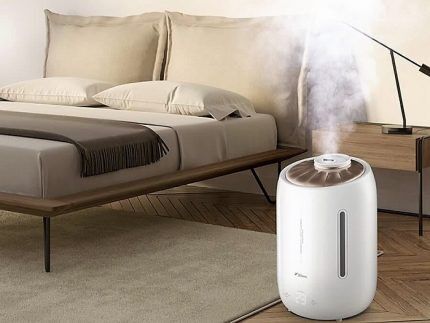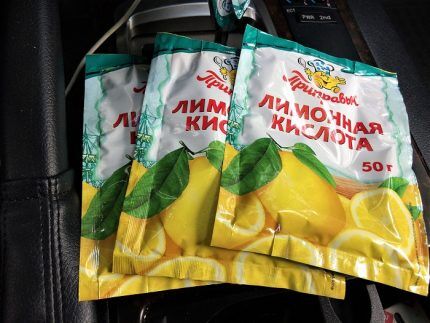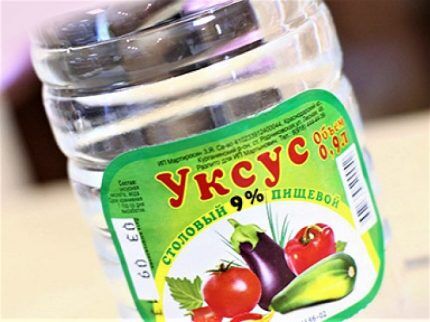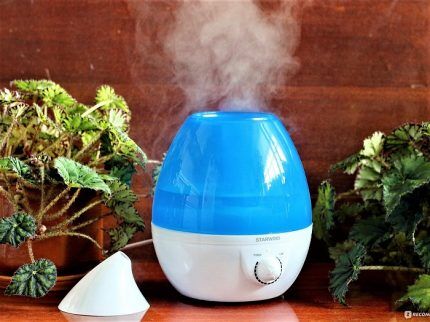How to clean a humidifier from scale and mold at home: the best methods + cleaning instructions
With the purchase of a humidifier, the microclimate in the room changes: the air becomes fresher, more humid, and if the device has a purifier function, it becomes cleaner. Many users notice that the improved atmosphere has a positive effect on their health: the immune system becomes stronger, and various viral and cold diseases become less frequent.
But purchasing a new household appliance also brings with it new responsibilities. You have to devote some time to a useful device - removing scale and rusty deposits, getting rid of mold.
Let us examine in detail how to clean a humidifier so that it does not lose its functions and does not fail prematurely. And at the same time, we will introduce you to safe cleaning and prevention products that will not harm either the residents or the electrical appliance.
The content of the article:
Reasons for contamination of a household humidifier
Of course, using a humidifier has a number of pros and cons. One of the latter is the need to regularly maintain it. But, before we start cleaning the devices, let’s find out where and for what reasons the pollution appears outside and inside.
Dirt on the outside of the housing and on the outer walls of the water tank appears from dust. The less often you clean, the faster the humidifier will get dirty.

If the plastic parts are still dirty on the outside, you just need to wipe them with a cloth soaked in soapy water. Do not use abrasives, which will instantly ruin the appearance of the device, destroy the gloss and leave small scratches.
Almost all parts of the humidifier, except the control panel, power supply and fan, are in contact with water. to take a closer look device and types of humidifiers, please follow the link.
It is more difficult to deal with contaminants on the internal walls, small plastic parts or in the tank. And they will appear in any case, because tap water, even filtered, contains a large number of various impurities.
Rust and lime, known to all housewives, remain the causes of stains, deposits and plaque.
In addition to them, the water contains:
- manganese;
- magnesium;
- sulfides;
- fluorides;
- chlorides;
- various organic compounds.
These and other compounds are constantly deposited on the plastic. And if you do not clean the humidifier in time, then microorganisms harmful to health will appear on the internal surfaces, or even grow mold.

You need to start fighting harmful microflora from the very first days of the appearance of a humidifier in the house, carrying out preventive measures.If you miss the moment, the evaporator, water tank, and all internal surfaces will become covered with an unpleasant rusty, yellowish or whitish coating.
But don't be alarmed - there are several proven means of getting rid of this dirt.
Review of safe and effective products
We will look at popular solutions that can always be found at home or bought in the supermarket. All of them are safe if you follow the dosage or instructions. But when working with aggressive chemicals or simply unknown substances, do not forget to use gloves, and if there is a strong smell, do not be lazy to wear a mask.
Remedy #1 - citric acid
Citric acid is found in many household cleaning products, but is also effective as a regular solution.

The food product, unlike the chemical reagent, is not dangerous, so special protective equipment does not need to be used.
Citric acid is used in different ways:
- wipe the contaminated areas with a cloth;
- apply to a brush and clean hard-to-reach places;
- pour the solution and leave for a while.
If you want to know how to properly clean a humidifier from mineral scale, remember the recipe for preparing the “magic remedy”. It is simple: dissolve 2-3 tbsp in 1 liter of water. spoons of acid powder. You can try a more concentrated solution - it won’t make it worse.
Filling inside containers is most effective.

The solution is left for 30-40 minutes, drained, and the softened salts are removed with a cloth or brush. Then rinse and wipe dry.
Citric acid is safe and effective against various deposits, therefore it is included in cleaning products officially approved by manufacturers of climate control equipment.
Remedy #2 – Baking Soda
Baking soda, which housewives often use for baking or cleaning kitchen utensils, is also suitable for cleaning a humidifier. It is as safe as citric acid, but, unlike it, it is an alkaline product.

It is not recommended to rub plastic parts with dry powder. As a result of such an aggressive approach, the surface will lose its smoothness, and deposits will “grow” even more. It is necessary to make a saturated solution - approximately 1 tbsp. spoon in a glass of water - and rub the contaminated areas with it.
After cleaning, all parts must be rinsed with clean water, either directly under the tap or in the shower. It is better to wipe the external surfaces dry so that there are no streaks left.
If you notice the first signs of mold, cover the affected areas tightly with baking soda and leave for a while. Alkali prevents the growth of fungus and also acts as an active antiseptic.
Remedy #3 – weak vinegar solution
Acetic acid acts on the principle of citric acid - it softens deposits and makes them more pliable during cleaning. But it is not recommended to use a concentrated solution; even table vinegar is recommended to be diluted with water.
The fact is that any acid can affect polymers in its own way. It is possible that microcracks will appear, which will contribute to rapid contamination. Therefore, before you start using vinegar, carefully read the manufacturer’s instructions - they usually list substances and solutions that cannot be used to clean or disinfect devices.

Usually table vinegar is combined with water in a 1:1 ratio, but if you use acid or essence, the percentage of water will be much higher.
After wiping with the solution, all parts must be thoroughly rinsed. Unlike soda, vinegar has a strong, persistent odor, and if you make too concentrated a solution, this “aroma” will remain in your apartment for a long time.
Remedy #4 – special detergents
Grandmother's products are good, but today you can find many more effective and equally safe special detergents on the market.
Let's consider one of them - a universal bathroom product from the popular Faberlic brand, which contains a whole complex of various acids.

The solution copes equally well with both red rust and difficult-to-remove lime deposits.
To avoid unpleasant consequences, it is recommended to first treat a small area of plastic and look at the result.If the structure of the material remains the same, but the dirt begins to lag behind, it can be used.
Procedure:
- Apply the composition to contaminated areas.
- Leave for 2-3 minutes.
- Treat with a sponge or brush.
- Rinse with water.
If the plaque is strong, you can increase the exposure time to 5 minutes, but no more. The procedure can be repeated several times until the deposits are completely destroyed.
If you decide to choose some household chemicals yourself, be sure to read the manufacturer’s recommendations. It’s better if the product can be used to clean dishes – then it’s really safe.
What solutions should not be used?
Wanting to achieve perfect cleanliness, users rub their devices with various compounds that are harmful not only to the plastic, but also to the health of the owners of the equipment themselves. To prevent them from accidentally being poisoned by harmful fumes, especially responsible manufacturers include in the instructions a long list of substances that are strictly prohibited to use. The list of permitted means, by the way, is much shorter.
The following are usually listed as prohibited:
- chlorine and any chlorine-containing solutions;
- aggressive concentrated acids;
- alcohol and alcohol-containing solutions;
- hydrogen peroxide;
- compositions with essential oils;
- petrol;
- kerosene;
- acetone and other solvents;
- toilet cleaners, etc.
Even light acidic products approved for use should not be left for long, as they can damage the structure of the material and significantly reduce the service life of the device.
Universal care instructions
The humidifier constantly needs preventative cleaning, even if it is new and has not yet become “overgrown” with a thick layer of plaque. This usually involves washing all parts with either clean water or a special solution.But no matter what kind of humidifier you have, the same instructions for regular maintenance can be applied to it.
Step-by-step instructions:
If the manufacturer has not left precise instructions for cleaning the filter, then rinse it with clean water to avoid damage.
If you decide to more seriously clean the filter of your home humidifier, proceed in the following order:
- Turn off the device.
- Carefully disconnect and remove the filter.
- Rinse under running water.
- If any dirt remains, soak in a solution of citric acid.
- Gently go over all critical areas with a soft brush.
- Wash away any remaining plaque with water.
- Dry and place on the workbench.
It is better to study the characteristics of the filter in advance by looking at the instructions. Some models have replaceable cartridges - they need to be changed on time. But there are also replaceable parts that you can clean several times yourself, and then buy new ones.
Prevention and maintenance rules
It is important not only use a humidifier correctly, but also take care of it regularly. After all, it is easier to prevent a problem from occurring than to deal with it later, so we recommend paying attention to the humidifier as often as possible.

We present you with a few simple rules that you should try to follow:
- The filter is cleaned once a week, all removable parts and the tank are cleaned once every 7-10 days;
- Before sanitary measures, the device must be disconnected from the power supply;
- Electronic parts, cord, plug, fan must not be filled with water;
- If the housing, fan, etc. are damaged during cleaning, the device cannot be turned on - repair is necessary;
- Use only those cleaning products recommended by the manufacturer.
Not everyone can use distilled or purchased purified water for filling.
But you can make your water supply much cleaner by installing filtration system – then your equipment will last longer, and your own health will noticeably improve.
Conclusions and useful video on the topic
Excellent cleaning effect from Faberlic detergent:
Recommendations for care from the manufacturer CRANE:
How to quickly and easily wash the filter:
Caring for household appliances is the responsibility of every user. Devices that are in constant contact with water require special attention. If you spend a few minutes each week on your humidifier, it will reward you with long-lasting, trouble-free operation that will benefit the entire family.
What products do you use to clean your humidifier of contaminants? Maybe you have special secrets for effective cleaning? Tell other users about them - the feedback block is located below. Also here you can ask questions to our experts or participate in a discussion of an issue that interests you.



